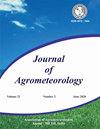旁遮普省气温和降雨时间序列预测的 ARIMA 方法
Q3 Agricultural and Biological Sciences
引用次数: 0
摘要
本研究旨在探讨季节自回归整合移动平均(SARIMA)模型在预测表现出季节性模式的气象时间序列数据方面的有效性。我们比较了不同配置的 SARIMA 模型的性能,并利用旁遮普省三个不同农业气候区(亚山区、中部地区和西南部地区)的实际气象数据集评估了其预报准确性,以预报月平均最高气温、最低气温和降雨量。亚山区(Ballowal Saunkhri)的气象数据从 1984 年至 2022 年,中部地区(Ludhiana)的气象数据从 1970 年至 2022 年,西南地区(Bathinda)的气象数据从 1977 年至 2022 年。研究结果深入揭示了 SARIMA 模型在气象预报中的适用性和局限性,并为该领域的从业人员和研究人员提供了实用建议。利用 Ljung-Box 检验对残差进行了拟合优度检验。使用平均绝对误差(MAE)和均方根误差(RMSE)检验了模型的准确性。该模型的最高气温平均绝对误差(MAE)为 0.61 至 0.78,最低气温平均绝对误差(MAE)为 0.74 至 0.49,降雨量平均绝对误差(MAE)为 32.12 至 45.44。拟合模型能够捕捉气温时间序列的动态变化,并做出合理的预报。然而,该模型无法有效预报降雨量序列。本文章由计算机程序翻译,如有差异,请以英文原文为准。
ARIMA approach for temperature and rainfall time series prediction in Punjab
The present study aims to explore the effectiveness of Seasonal Autoregressive Integrated Moving Average (SARIMA) models in forecasting meteorological time series data exhibiting seasonal patterns. We compared the performance of SARIMA models with different configurations and evaluate their forecasting accuracy using real-world meteorological datasetsfor three different agroclimatic zones of Punjab (sub mountainous region, central region and south west region) was analyzed to forecast mean monthly maximum air temperature, minimum air temperature and rainfall. The weather data was used from 1984-2022 for sub-mountainous zone (Ballowal Saunkhri), 1970-2022 for Central zone (Ludhiana) and 1977-2022 for south west zone (Bathinda). The results provide insights into the suitability and limitations of SARIMA models for meteorological forecasting and offer practical recommendations for practitioners and researchers in the field. The goodness of fit was tested against residuals using Ljung-Box test. The accuracy of the model was tested using Mean Absolute Error (MAE) and root square mean error (RMSE). The model achieved Mean Absolute Errors (MAE) ranging from 0.61 to 0.78 for maximum temperature, 0.74 to 0.49 for minimum temperature, and 32.12 to 45.44 for rainfall, with lower MAE values indicating higher predictive accuracy. The fitted model was able to capture dynamics of the temperature time series and produce a sensible forecast. However, the model was unable to forecast rainfall series efficiently.
求助全文
通过发布文献求助,成功后即可免费获取论文全文。
去求助
来源期刊

Journal of Agrometeorology
农林科学-农艺学
CiteScore
1.40
自引率
0.00%
发文量
95
审稿时长
>12 weeks
期刊介绍:
The Journal of Agrometeorology (ISSN 0972-1665) , is a quarterly publication of Association of Agrometeorologists appearing in March, June, September and December. Since its beginning in 1999 till 2016, it was a half yearly publication appearing in June and December. In addition to regular issues, Association also brings out the special issues of the journal covering selected papers presented in seminar symposia organized by the Association.
 求助内容:
求助内容: 应助结果提醒方式:
应助结果提醒方式:


